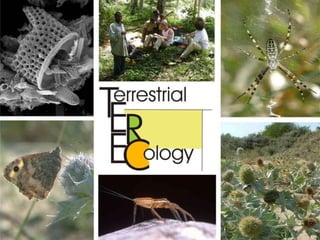
Ecology Report
- 2. Outline Terrestrial Environment Terrestrial Biota and Biogeographic Regions General Structure of Terrestrial Communities Soil Subsystem Vegetation Subsystem Distribution of Major Terrestrial Communties , The Biomes
- 3. Terrestrial Environment Climate a. Moisture – major limiting factor on land b. Temprature variations and extremes c. Air circulation – ready mixing and constant content of oxygen and carbon dioxide
- 4. 2. Substratea. Soil – offers solid support and source of highly variable nutrientsb. Land – provides geographical barriers to free movement
- 11. 2. Chamaephytes-surface plants; renewal bud at the surface of the ground 3. Hemicryptophytes- buds at or near the soil surface Catharanthuspusillus(Tiny_Periwinkle) Daisies or BellisPerennis
- 12. 4. Cryptophytes-earth plants; buds lying beneath the surface of the ground Geophytes - resting in dry ground, e.g. crocus. Helophytes - resting in marshy ground, e.g. reed mace, marsh-marigold Hydrophytes - resting by being submerged under water
- 13. 5. Therophytes- annual plants which survive the unfavorable season in the form of seeds 6. Aerophytes - obtains moisture and nutrients from the air and rain
- 14. 7. Epiphytes- air plants; no roots in the soil
- 15. Raunkiær system
- 16. a. Vegetation – refers to all the plants in general or the mass of plants growing in a particular place. b. Flora – refers to a list of taxonomic entities to be found in an area
- 20. Actinomycetes
- 22. Soil Respiration 3 methods todetemine total soil metabolism Difference Method – subtracting the energy consumed by above-ground herbivores from net primary production Litter fall method – determining the amount and energy value of the detritus (litter) input into the soil subsystem Direct measurement of CO2
- 24. Constancy-percent of plots containing the species
- 27. Distribution of the Earth's Eight Major Terrestrial Biomes. (Adapted from: H.J. de Blij and P.O. Miller. 1996. Physical Geography of the Global Environment. John Wiley, New York. Pp. 290.)
- 31. coldest and harshest biome in the world
- 32. permafrost – permanent frozen deeper soil layer
- 33. vegetation mainly comprises of dwarf shrubs, grass, moss and lichen
- 35. also referred as theboreal forest or taiga.
- 36. Trees primarily possess pine needles instead of broad leaves like those of the temperate forests to the south.
Hinweis der Redaktion
- Vertebrates dominates the land today, and this includes the growing human population.
- Alfred Russell Wallace, who with Charles Darwin coauthored one of the first statements of natursl selection, early realized and set up one of the first systems of biogeographical regions
- If in the vast open sea, which what we call pelagic realm, tha primary producers are the pytoplankton, in land habitat we have green plants which dominate the land
- Raunkiær’s life forms are based on the place of the plant's growth-point or the renewal bud during seasons , and the corresponding protection provided duringunfavorable cold or dry periods.
- Anacyclus clavatus
- The first two groups utilize the more readily decomposable organic substances such as sugars, amino acids, and simple proteins. The cellulose bacteria then work on the more resistant compounds, while the actinomycetes are especially associated with humus, which is the dark, yellow-brown, very resistant end product of the process of decomposition called humification.
- A fundamental classification of biomes is:Aquatic biomes (including Freshwater biomes and Marine biomes). Climax vegetation is the vegetation which establishes itself on a given site for given climatic conditions in the absence of anthropic action after a long time (it is theasymptotic or quasi-equilibrium state of the local ecosystem).
- Pyramid showing comparison of different biomes based on moisture and temperature.
- The extremely cold temperature in this region is not at all suitable for human habitation. The permafrost, which lies about six inches below the surface, remains frozen throughout the year.
